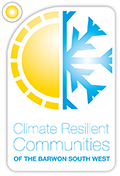Taking the findings from Stage 1 of the Project into consideration (as outlined in Section 4 of this report), the group undertook an activity which focused on identifying the main risks for their organisations and for the Region. This was based on a suite of scenarios made up of the expected future changes to the climate exposure (temperature, precipitation, sea level rise) and the Regions sensitivities (social, economic and environmental).
The risk statements that were raised are in the following table.
| Exposure Indicator | Vulnerability Indicator | ||
|---|---|---|---|
| Social | Economic | Environmental | |
|
Temperature An increase in mean temperature and/or extreme heat events could lead to: |
|
|
|
|
Precipitation A decrease in precipitation and less frequent 50mm rainfall events could lead to: |
|
|
|
|
Sea Level Rise A SLR and/or storm surge could lead to: |
|
|
|
Table 9: Regional risks
Regional partner strategic discussion
Actions








